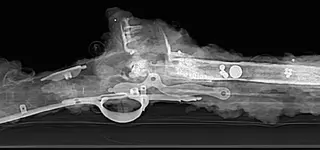Yes... in Historical Artillery nomenclature, the term "Case-Shot" means ONLY explosive artillery shells which contain anti-personnel balls/slugs/wedges -- or the balls/slugs/wedges from a Case-Shot shell. So, that is what I thought you meant. Insofar as I'm aware, no Case-Shot balls (nor Grape-Shot balls, nor Canister-Shot balls) smaller than .5-inch ever existed.
Because the you said the balls you found weigh 10 to 10.5 grams, they absolutely cannot be .54-caliber musketballs... which weigh approximately 221 grains (14.32 grams).
There is a serious contradiction between the size-measurement (.50-to-.52") and weight-measurements (10-to-10.5 grams) you are reporting. All I can suggest to resolve the conflict is to re-weigh the balls on a scale which tells the weight in grains.
Other readers may want to see my response to your PM, because it also answers what's in your posts... so here's the text of my PM reply.
Tidajo said:
Thanks for the info you provided regarding what I thought may have been case shot.
You sent me back to the drawing board, where I am now looking at "buck and ball" (see my response on the post).
"I find this online:
In October 1777, General Washington recommended the men deliver their first volley with a load of “one musket ball and four or eight buckshot, according to the strength of their pieces.” And from Army GENERAL ORDERS, Head Quarters, Perkiomy, October 6, 1777; “buckshot are to be put into all cartridges which shall be hereafter made."
•The majority of excavated shot displayed from our Ft. Clinton, lost and destroyed by the British in Oct. 1777, are clearly larger than .25 and appear to average in the low .30’s
•Thomas’ three-volume tome, Round Ball to Rimfire, demonstrates pre-Civil War buckshot as .30 from the Hudson Highlands in 1781 as well as
•a packet of ten cartridges possibly of Rev. War vintage where the buckshot in the one removed for testing shows to be greater than .25 next to the .69 caliber ball they sit atop.
•A curator at the West Point Museum shared that they have two known-to-be Rev. War buck-n-ball cartridges there and the x-rayed buckshot is .32 diameter.
•The Heidelberg College excavation of the 1795 Fallen Timber Battlefield found three .25 pellets vs. 35 .31 pellets. "
Do you think I'm in the right direction? Or still wrong caliber?
thanks!
Tidajo, the key to solving the riddle is the super-precise measuring of the weight of the (lead) balls. Smashing a lead ball or bullet changes the projectile's shape but does not change its weight. As I said in my previous posted reply, the precise weight you reported (10-to-10.5 grams) matches up with a lead sphere whose diameter is approximately .475 to .48-inch. As your other research shows, buckshot and the "buck" from Buck-&-Ball loads are typically .31 to .32 for .69-caliber Buck-&-Ball ammo. You can see the proportionate sizes of the 3 small balls and one large ball in the x-ray loaded-musket photo you posted. The "buck" are a bit smaller (such as .25-inch) when the single large ball is smaller than .69-caliber.
I have not personally used a .50-caliber musket or Colonial-era .50 rifle such as a Hawken. I've been told that because a cloth "patch" was supposed to be used to wrap the lead ball in those .50-cal firearms, the ball was about .46-inch in diameter. If what I was told is correct, your precise-weight-indicated .475-to-.48" balls are slightly too large to be Colonial-era .50-caliber musket/rifle balls.
I really do wish I had happier news to give you, but all I can do is provide the facts... which can sometimes be disappointing to us relic-diggers.














